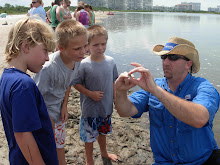 |
| Arrows point to muscle tissue hanging from a stone crab claw that was improperly removed. Image credit: FWC |
Stone
crabs, like other crabs, naturally lose claws from time to time, and the
survival rate is close to 100%. In the fishery, however, survival depends
greatly on fishermen correctly removing the claws. If the joint linking the body
to the claw is left intact, a stone crab has a good chance of surviving and
regenerating its claw. After a claw is removed, a thin layer of tissue called
the diaphragm instantly acts as a seal to close the wound and stops any
bleeding. Claws should never be twisted
off as this can result in muscle being torn from the crab’s body. Instead a
claw should be removed with a quick, downward snap at the body/claw joint to ensure
the diaphragm can work correctly.
Despite
what many people think, it is legal
to remove both claws of a stone crab if they both meet the minimum size
requirement of 2 and ¾ inches. Removing
both claws, however, will reduce the likelihood of the crab being able to
defend itself, and will increase the amount of time it takes to obtain food.
The more a crab eats, the more energy it will have to re-grow new claws. A
healthy adult crab can regenerate a lost claw in about a year, but it takes up
to three years for it to approximately reach its original size. Often the largest
crabs won’t even fully regenerate their claws because of their relatively old
age. For a full listing of the recreational stone crab regulations visit: http://myfwc.com/fishing/saltwater/regulations/stone-crabs/.
Happy
crabbing!
 |
| The arrow is pointing to a new claw bud forming. Image credit: FWC |


